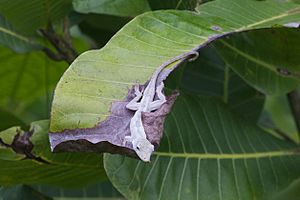Lichen anole facts for kids
Quick facts for kids Lichen anole |
|
|---|---|
 |
|
| Conservation status | |
| Scientific classification | |
| Genus: |
Anolis
|
| Species: |
pentaprion
|
The lichen anole (scientific name: Anolis pentaprion) is a small lizard. It belongs to the family called Dactyloidae. These interesting lizards are found in parts of Central and South America. You can find them in countries like Nicaragua, Costa Rica, Panama, and Colombia.
Contents
What is the Lichen Anole?
The lichen anole is known for its amazing camouflage. Its skin often has colors and patterns that look like lichens. Lichens are small, plant-like growths found on trees and rocks. This helps the anole blend in perfectly with its surroundings. It makes it very hard for predators to spot them.
These lizards are usually small to medium-sized. Like other anoles, they have a special throat flap. This flap is called a dewlap. Males often have a larger, colorful dewlap. They use it to attract mates and to show off to other anoles.
Where Do Lichen Anoles Live?
Lichen anoles prefer to live in tropical forests. They are often found on tree trunks and branches. Their camouflage helps them hide among the bark and lichens. They like warm, humid places. These forests provide plenty of food and hiding spots.
They live in different elevations. This means they can be found in lowlands or higher up in the mountains. Their range covers several countries in Central and South America.
What Do Lichen Anoles Eat?
Lichen anoles are insectivores. This means they mainly eat insects. Their diet includes small bugs, spiders, and other tiny creatures. They are active during the day. They hunt for food by waiting patiently. When an insect comes close, they quickly snatch it.
Their sharp eyesight helps them spot prey. They are important in their ecosystem. They help control insect populations.
How Do Lichen Anoles Reproduce?
Lichen anoles reproduce by laying eggs. The female anole will lay her eggs in a safe spot. This is usually in soft soil or under leaf litter. The eggs are small and soft-shelled.
After a period, the baby anoles hatch from the eggs. They are tiny versions of the adults. They must find food and avoid predators on their own. The life cycle of an anole involves growing from a hatchling to an adult.
See also
In Spanish: Abaniquillo liquen para niños


